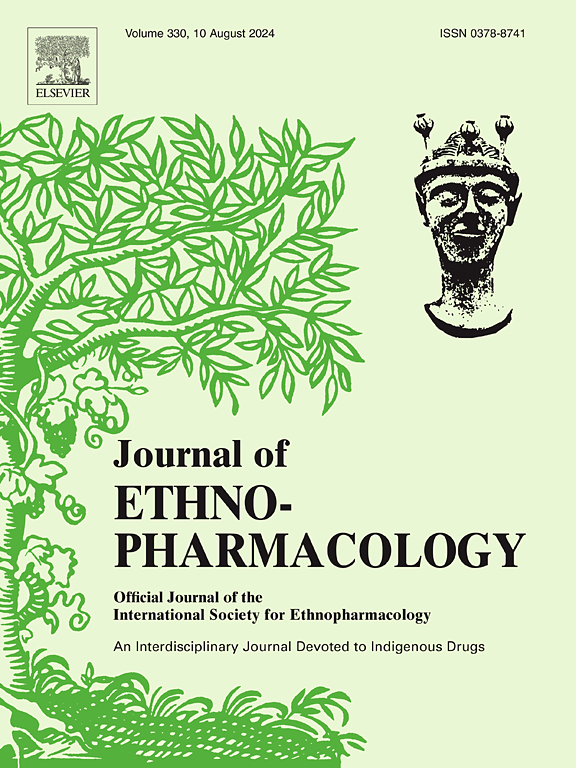雷公藤糖苷片和雷公藤甲素可通过PACAP/cAMP信号通路缓解实验性自身免疫性脑脊髓炎小鼠。
IF 4.8
2区 医学
Q1 CHEMISTRY, MEDICINAL
引用次数: 0
摘要
民族药理学相关性:雷公藤是一种传统的中国草药,已被用于治疗自身免疫性疾病,包括类风湿关节炎和系统性红斑狼疮。雷公藤糖苷片(TGT)是雷公藤的衍生品,在中国广泛应用于临床。然而,TGT对多发性硬化症(MS)的治疗作用,特别是通过其活性成分雷公藤甲素(TP)的治疗作用,仍未得到充分的了解。研究目的:本研究旨在探讨TGT和TP对实验性自身免疫性脑脊髓炎(EAE)的治疗作用,并阐明其分子机制。材料和方法:采用液相色谱-四极杆飞行时间质谱法对TGT和TWPT进行化学表征。在EAE模型中评价TGT、TWPT和TP的治疗效果。蛋白质组学分析和western blot分析验证了信号通路。结果:TGT和TP可显著缓解小鼠EAE症状,包括减轻体重和神经功能缺损,而TWPT(不含雷公藤甲素的TGT)无显著治疗效果。组织学分析显示,TGT和TP可减少脊髓脱髓鞘和炎症细胞浸润。TGT和TP降低全身炎症因子(IL-17A、IFN-γ、TNF-α和IL-6)和脊髓转录因子T-bet和ROR-γt的mRNA表达。蛋白质组学分析表明,TP显著上调PACAP的表达,激活cAMP信号通路。此外,TGT和TP可调节PKA、PI3K-AKT、NF-κB和凋亡相关信号通路,减轻EAE小鼠的炎症、凋亡和脱髓鞘。结论:TGT和TP通过PACAP/cAMP信号轴发挥抗炎和改善脱髓鞘作用,减轻小鼠EAE的临床和病理表现,TGT是治疗MS的有效策略。本文章由计算机程序翻译,如有差异,请以英文原文为准。

Tripterygium glycoside tablets and triptolide alleviate experimental autoimmune encephalomyelitis mice involving the PACAP/cAMP signaling pathway
Ethnopharmacological relevance
Tripterygium wilfordii, a traditional Chinese herbal medicine, has been used for treating autoimmune diseases, including rheumatoid arthritis and systemic lupus erythematosus. Tripterygium glycoside tablets (TGT), derived from this herb, is widely used in clinical practice in China. However, the therapeutic effects of TGT on Multiple sclerosis (MS), particularly through its active component triptolide (TP), remain insufficiently understood.
Aim of the study
This study aimed to investigate the therapeutic effects of TGT and TP on experimental autoimmune encephalomyelitis (EAE) and elucidate the underlying molecular mechanisms.
Materials and methods
TGT and TWPT were chemically characterized using liquid chromatography coupled with quadrupole time-of-flight mass spectrometry. The therapeutic effect of TGT, TWPT, and TP was evaluated in the EAE model. Proteomics analysis and Western blot analysis were validated the signaling pathways.
Results
TGT and TP significantly alleviated EAE symptoms in mice, including reduced weight loss and neurological deficits, whereas TWPT (TGT without triptolide) shows no significant therapeutic effect. Histological analysis revealed that TGT and TP reduced demyelination and inflammatory cell infiltration in the spinal cord. TGT and TP decreased systemic inflammatory cytokines (IL-17A, IFN-γ, TNF-α, and IL-6) and the mRNA expression of the transcription factors T-bet and ROR-γt in the spinal cord. Proteomic analysis indicated that TP significantly upregulated the expression of PACAP and activated the cAMP signaling pathway. Furthermore, TGT and TP modulate PKA, PI3K-AKT, NF-κB, and apoptosis-related signaling pathways, contributing to the reducing inflammation, apoptosis and demyelination in EAE mice.
Conclusion
TGT and TP exert anti-inflammatory and demyelination-improving effects to alleviate both clinical and pathological manifestations of EAE in mice via the PACAP/cAMP signaling axis, suggesting TGT as promising therapeutic strategies for MS.
求助全文
通过发布文献求助,成功后即可免费获取论文全文。
去求助
来源期刊

Journal of ethnopharmacology
医学-全科医学与补充医学
CiteScore
10.30
自引率
5.60%
发文量
967
审稿时长
77 days
期刊介绍:
The Journal of Ethnopharmacology is dedicated to the exchange of information and understandings about people''s use of plants, fungi, animals, microorganisms and minerals and their biological and pharmacological effects based on the principles established through international conventions. Early people confronted with illness and disease, discovered a wealth of useful therapeutic agents in the plant and animal kingdoms. The empirical knowledge of these medicinal substances and their toxic potential was passed on by oral tradition and sometimes recorded in herbals and other texts on materia medica. Many valuable drugs of today (e.g., atropine, ephedrine, tubocurarine, digoxin, reserpine) came into use through the study of indigenous remedies. Chemists continue to use plant-derived drugs (e.g., morphine, taxol, physostigmine, quinidine, emetine) as prototypes in their attempts to develop more effective and less toxic medicinals.
 求助内容:
求助内容: 应助结果提醒方式:
应助结果提醒方式:


